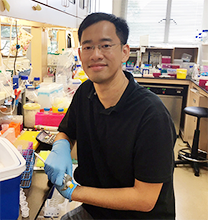Education
| 2008 | PhD, University of Nottingham |
| 2003 | MSc, University of Nottingham |
| 2002 | BSc, Jilin University |
Position
- 2019 Associate Professor, School of Life Sciences
- 2013 Assistant Professor, School of Life Sciences
Research Interests
- Epigenetics and genomics
- Hormone signaling network
- Fruit ripening
- Sequencing technology
Representative Publications
- Tu, X., S. Ren, W. Shen, J. Li, Y. Li, C. Li, Y. Li, Z. Zong, W. Xie, D. Grierson, Z. Fei, J. Giovannoni, P. Li and S. Zhong (2022). Limited conservation in cross-species comparison of GLK transcription factor binding suggested wide-spread cistrome divergence. Nature Communications 13(1): 7632.
- Dai, X., Tu, X., Du, B., Dong, P., Sun, S., Wang, X., Sun, J., Li, G., Lu, T., Zhong, S., & Li, P. (2022). Chromatin and regulatory differentiation between bundle sheath and mesophyll cells in maize. The Plant Journal, 109(3), 675–692.
- Tu X, Marand AP, Schmitz R, Zhong S (2022) A combinatorial indexing strategy for low-cost epigenomic profiling of plant single cells. Plant Communications, 100308.
- Tu X., Mejía-Guerra M.K., Franco J.V., Tzeng D., Chu P.Y., Shen W., Wei Y., Dai X., Li P., Buckler E and Zhong S. (2020) Reconstructing the maize leaf regulatory network using ChIP-seq data of 104 transcription factors. Nature Communications. 5089.
- Dong, P., Tu X., Liang Z., Kang BH. and Zhong S. (2020) Plant and animal chromatin three-dimensional organization: similar structures but different functions. Journal of Experimental Botany. 71:5119-5128.
- Dong, P., Tu, X., Li, H., Zhang, J., Grierson, D., Li, P., and Zhong, S. (2020) Tissue-specific Hi-C analyses of rice, foxtail millet and maize suggest non-canonical function of plant chromatin domains. Journal of Integrative Plant Biology. 62, 201-217.
- Gao Y., Zhu N., Zhu X., Wu M., Jiang C., Grierson D., Luo Y., Shen W., Zhong S., Fu D., and Qu G. (2019) Diversity and redundancy of the ripening regulatory networks revealed by the fruitENCODE and the new CRISPR/Cas9 CNR and NOR mutants. Horticulture Research. 6:39.
- Lv, P., Yu, S., Zhu, N., Chen, Y., Zhou, B., Pan, Y., Tzeng, D., Fabi, J., Argyris, J., Garcia-Mas5, J., Ye, N., Zhang, J., Grierson, D., Xiang, J., Fei, Z., Giovannoni, J., and Zhong S. (2018) Genome encode analyses reveal the basis of convergent evolution of fleshy fruit ripening. Nature Plants. 4:784-791.
- Dong P., Tu X., Chu P.Y., Lv P., Zhu N., Grierson D., Du B., Li P., and Zhong S. (2017). 3D Chromatin Architecture of Large Plant Genomes Determined by Local A/B Compartments. Molecular Plant. 10, 1497-1509.
- Zhong S, Fei Z, Chen YC, Zheng Y, Huang M, Vrebalov J, Gapper N, McQuinn R, Liu B, Xiang J, Shao, Y and Giovannoni J (2013) Single-base resolution methylomes of tomato fruit development reveal epigenome modifications associated with ripening. Nature Biotechnology. 31:154-159.
Research Grants
- 2021: GRF, Investigate the single cell epigenome of tomato fruit, HK$ 1,394,799.
- 2020: GRF, Genome-wide demethylation and 3D chromatin structure alteration during early tomato fruit development, HK$ 1,320,623.
- 2019: GRF, Chasing the genetic and epigenetic origin of the tomato fruit ripening mechanism. HK$ 935,530
- 2018: GRF, Pan-epigenome Analysis of Fruit Ripening. HK$ 1,278,357.
- 2016: GRF, Use the ripening gas ethylene and tomato as a model to investigate the molecular mechanism of tissue-specific hormone signaling. $1,320,363.
- 2015: ITF-Tier3, Development of a plasma-based plant growth light for agricultural use. $1,390,350.
- 2015: GRF, Epigenome reprogramming and chromatin accessibility during tomato fruit development. $1,542,740.
Awards
- 2014: U.S. Secretary of Agriculture Honor Award in the category of Increasing global food security.
- 2009: Human Frontier Science Program Long-term Fellowship Award.




